We first discovered the painterly art quilts of Colorado artist Deidre Adams through our interview with Heather Dubreuil, who cited Deidre as a major influence on her work. Adams’ abstract mixed media textile art is inspired by ‘the quiet beauty found in the imperfect and the impermanent’. She has a Bachelor of Fine Arts from the Metropolitan State University of Denver, a degree in Computer Information Systems & Management Science and previously worked as a Graphic Designer for Quilter’s Newsletter magazine.
In our interview with Deidre she talks about overcoming a self-conscious attitude towards drawing and explains why her work is a reaction against the culture of consumption.
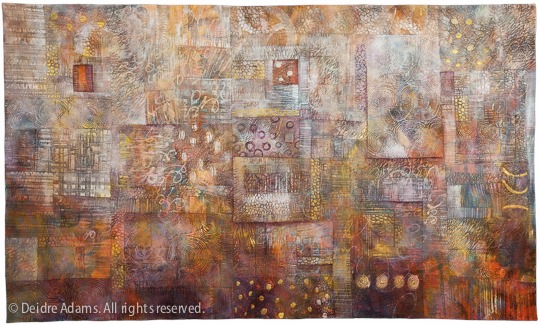
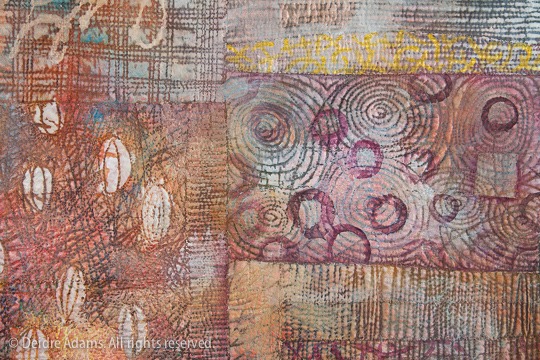
Just part of daily life
TextileArtist.org: What or who were your early influences and how has your life/upbringing influenced your work?
Deidre Adams: When I was very young, my maternal grandmother was an oil painter. Of course I didn’t realize it at the time, but there was something about the smell of the paints and the idea that you could take a blank canvas and create a scene of your own making that was tremendously influential in my development.
What was your route to becoming an artist? (Formal training or another pathway?)
I’ve always loved making things with my hands. I was one of those kids who was always coloring and drawing. In elementary school, my favorite part of the day was when we worked on an art or craft project. I made pictures of animals with macaroni and silver spray paint, potholders woven from nylon loops, ojos de dios with yarn wrapped around crossed popsicle sticks, and “stained glass” from waxed paper and crayon shavings. I never thought of any of this as art, though; it was just part of daily life.
At some point, I became self-conscious about my drawing skills. I took one art class in high school, but I didn’t think I was any good at it, so I didn’t continue. I didn’t realize there were ways to make art other than a well-rendered representational drawing or painting. I still made things on my own, though. I knitted, crocheted, painted with watercolor, and made crafty things from magazine articles.
When I went to college a bit later, my first degree was in Computer Information Systems & Management Science. But I used my elective credits requirements to take drawing and painting classes. Twenty years later, after continuing to make art on my own, I decided that this was something really important to me, and I went back to school and got my BFA (Bachelor of Fine Arts).
Tell us a bit about your process and what environment you like to work in?
Henri Matisse said, “An artist is an explorer. He has to begin by self-discovery and by observation of his own procedure. After that he must not feel under any constraint.”
I think this idea gets to the heart of what an artist tries to do, no matter what themes or subject matter or medium the artist chooses to work in. I think people choose to be artists because it helps us to discover who we are and to find a strategy for living in a world that often doesn’t make sense.
On a given day, I may choose to work with fabric and stitch, on another day I might work with paper or with paint. I like to make things with my hands; I like to create and observe color interactions. Being able to make things is a glorious experience, simultaneously joyful and introspective.
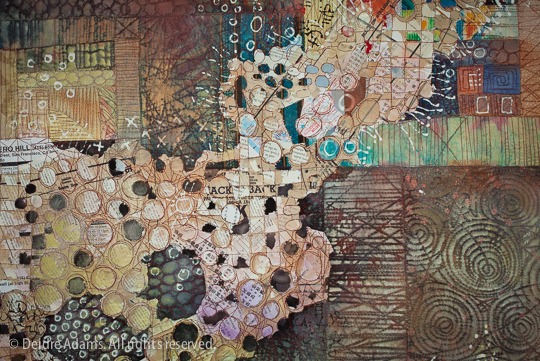
How has your work developed since you began and how do you see it evolving in the future?
I became interested in quilting when my son was born. I began with very traditional quilts—baby quilts, then a couple of things from patterns. I started buying magazines and teaching myself by reading everything I could find. When I went to work for Quilter’s Newsletter magazine as a graphic designer, it was an epiphany to see the beautiful quilts that came in for photography. It gave me an understanding of how quilting is an art form in itself, and I saw how the basic techniques could be built upon in ways I had never dreamed of. I took a variety of workshops and learned fabric dyeing and painting as well as various piecing, appliqué, and other construction techniques.
As my work evolved, I became more interested in the function of the stitched line and less in the fabric I was using. When I discovered that I could use paint to emphasize the stitching, that became the primary focus of my work. I simplified the construction of the top layer, choosing fabrics at random, with an eye toward how the pattern and color would create underlying visual texture as the base of my layering process. I started using more and more stitching, partly because it serves my purpose, and partly because I find it a very enjoyable process.
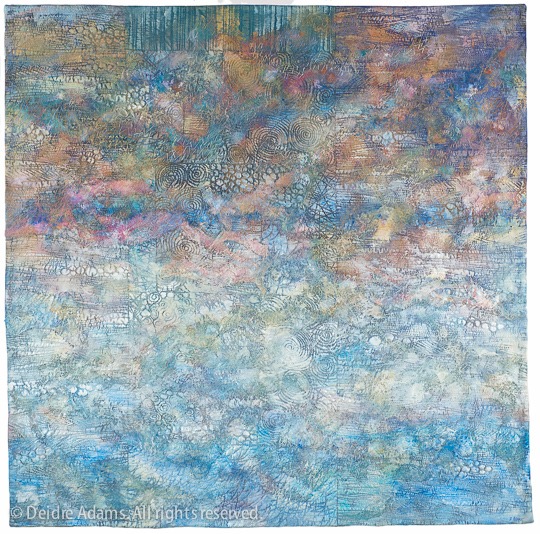
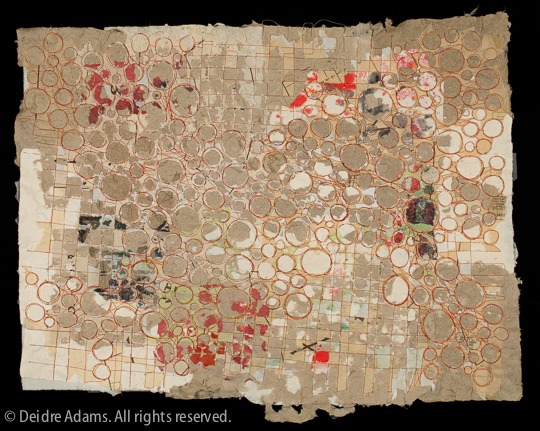
Celebrating random imperfections
What currently inspires you?
Our culture has for some time been driven by our desire to possess and consume. As we move ever closer to unrestrained materialism, we’re losing our connection to the earth and to one another. While we long to find meaning in our lives, we constantly discard and replace our possessions — we need something newer, shinier, and with more features than we can ever possibly understand or use to give us the illusion of fulfillment. We are losing our understanding of what it means to be human as we become immersed in a world of electronics and video screens, and our relationships with others are conducted entirely through these gadgets. These mass-produced objects have no life or energy; on the contrary, then drain us of our own energy. Lately I’ve realized that the aesthetic of my work has evolved as a reaction to this world.
[easyazon_link asin=”0981484603″ locale=”UK” new_window=”default” nofollow=”default” tag=”wwwtextileart-21″ add_to_cart=”default” cloaking=”default” localization=”default” popups=”default”]Wabi-sabi is a Japanese concept for which there is no exact counterpart in the western world, but part of what it entails is a reverence for impermanence and the expression of a balance between the love of life and the melancholy sadness of life’s passing. Wabi sabi celebrates the asymmetry and random imperfections of the natural world. All things are in a constant state of flux; they evolve from nothing and devolve back to nothing.
In the last several years, I’ve found myself attracted more and more to surfaces that bear the marks of time and transformation. Buildings and objects made by human industry, left in the environment, are affected over time by weather and human activity. The breakdown of metals and paints, oxidation and rust, watermarks and graffiti, all of these are added in layers over time, resulting in surfaces of unintended but profound beauty. I’ve been taking pictures of these textures for over ten years. Although I don’t create literal representations of these objects and surfaces in my paintings, I’ve internalized their appearance and character to the extent that their presence in my mind affects everything I do.
I’m also interested in the marks humans put on things. Graffiti is one example of this, but also markings made in the course of daily human industry, such as handmade signs or construction directions made in the road with spray paint. Printed or hand-written letterforms and words combine to make a texture or pattern or are just fascinating in their own right.
My latest fascination is using printed paper. I have a large collection of old textbooks: physics, chemistry, engineering, etc. I’m using pages from these plus reference books, dictionaries, maps, sheet music, newspapers in other languages, and other things I find. I’m layering these and stitching them together, before I begin a process of peeling back the various layers to see what’s beneath. I think of it as a kind of reverse archaeology as I layer them; and then it’s like an excavation going back down. The idea is about the different systems of knowledge that we have, but how all of it is not accessible to everyone.
Which other artists do you admire and why?
Mark Bradford, both for the rich and densely layered surface textures of his paintings, and for his use of everyday materials found in his immediate environment, like advertising posters and end papers from hair salons.
Robert Ryman, for his lack of pretentiousness and for his ability to show us how slowing down and taking the time to really look can reveal the beauty of simplicity.
Cy Twombly, for his grand gestural mark-making and for his use of the written word.
Jane Lackey, for her conceptual work concerning text and communication, and for her innovative use of materials.
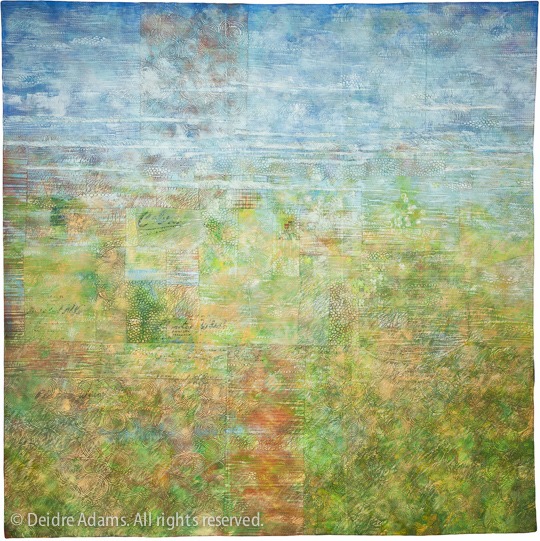
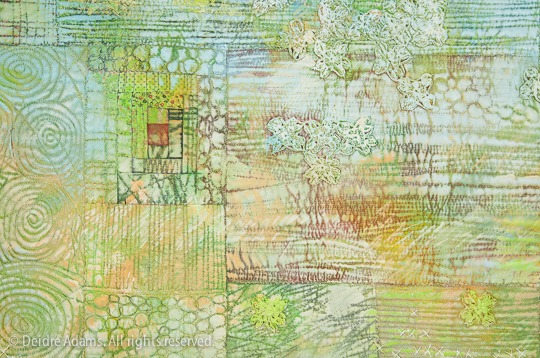
Tell us about a piece of work you have fond memories of and why?
Horizon XVIII: Plainsong was an important piece for me. It was commissioned by a library in the small town of Bennett, Colorado, in 2011. Part of the requirement for the commission was that the local community needed to be involved somehow. The library was simultaneously creating an oral history of the area, and so we interviewed residents to gather their impressions and memories of living in this once rural farming community. I asked people to bring in some kind of fabric item that had held some history for them – perhaps a utilitarian item like an old worn dishtowel, or an item of clothing no longer in use.
I received a wide variety of things including a work shirt, a threadbare dishtowel, part of a baseball jersey, a crocheted doily, fabric left over from the making of a formal prom dress, even a couple of quilt blocks. Horizon XVIII is made entirely of these donated fabrics. I created a map of where each piece was located within the work, and at the dedication reception, people enjoyed finding and pointing our their contributions to their friends.
I wrote a 6-part blog series on the making of this commission, which shows my process in detail. Part 1 is here.
What advice would you give to an aspiring textile artist?
Many aspiring textile artists come from a background of quilting or crafting and have no training in art. This isn’t necessarily a bad thing, but if you never learned anything about design, composition, or color theory, you will be at a disadvantage. Take classes in these things, or learn about them from books or online.
Don’t limit yourself to observing the work of other textile artists. Look at paintings, sculpture, assemblage, conceptual art. Once you’ve learned a number of techniques, stop taking classes for a while and just go into the studio by yourself and make things. You can learn a lot more by dedicated exploration on your own than you can by taking more workshops. Give yourself time to learn and grow, and don’t be frustrated by failed work. If you don’t fail sometimes, you’re not trying hard enough.
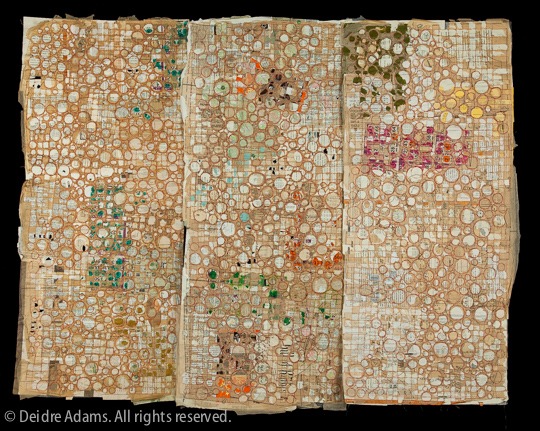

Advice and upcoming exhibitions
Can you recommend 3 or 4 books for textile artists?
These books contain timeless observations on how to work through self-limiting fears and inhibitions. I recommend them to every artist.
[easyazon_link asin=”0393311066″ locale=”US” new_window=”default” nofollow=”default” tag=”textileaorg0a-20″ add_to_cart=”default” cloaking=”default” localization=”default” popups=”default”]The Courage to Create , by Rollo May
What other resources do you use?
The Surface Design Journal is my favorite; I read it cover to cover. I also subscribe to ArtNews.
What piece of equipment or tool could you not live without?
If you don’t limit your ideas, you may find that there is no tool that is indispensable. For me personally, as long as I have a needle and thread, or even something as basic as a pencil and paper, I can make something. Sometimes having limitations can be the most liberating experience of all.
Where can readers see your work this year?
My invitational solo show Tracings is on view at Visions Art Museum in San Diego, California.
For more info please visit: deidreadams.com and Instagram.
If you’ve enjoyed this interview with Diedre please let us know by leaving a comment below
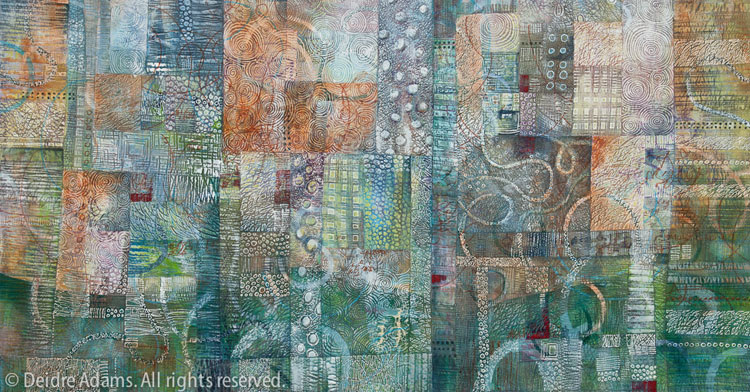
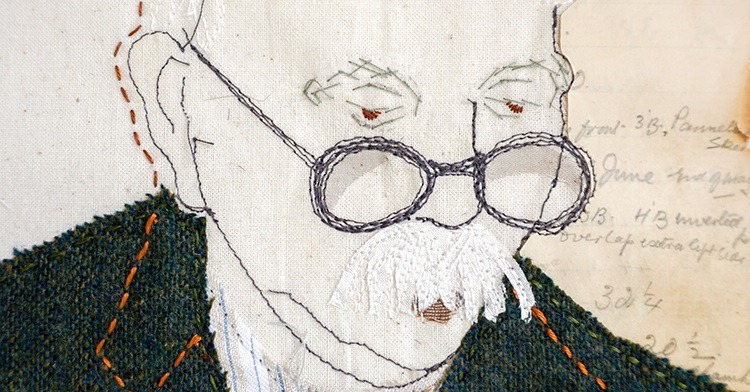
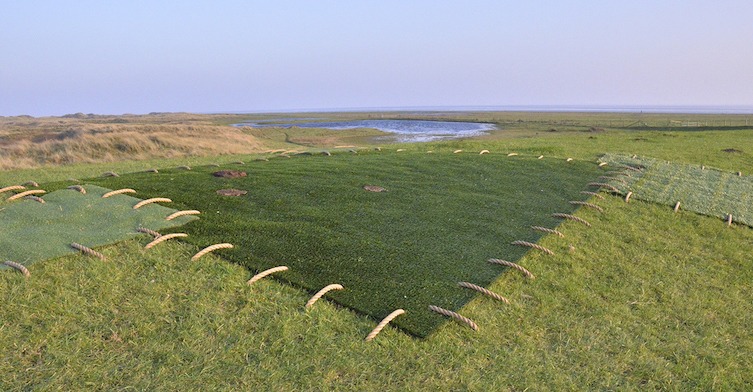
![Contemporary textile artist Lisa Solomon|Lisa Solomon - Sanjusangendo crowns [gold] - detail](https://www.textileartist.org/wp-content/uploads/Lisa1.jpg)
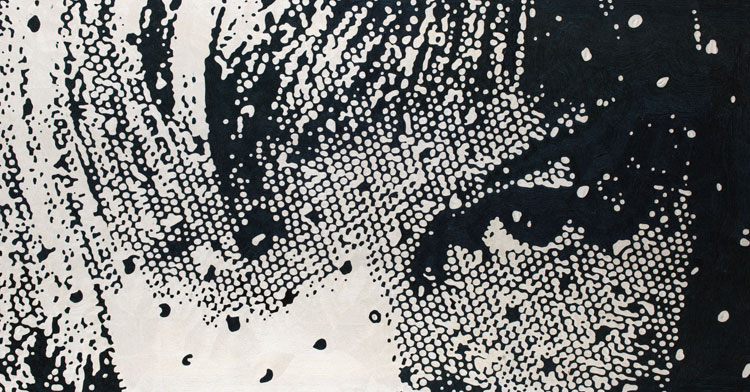
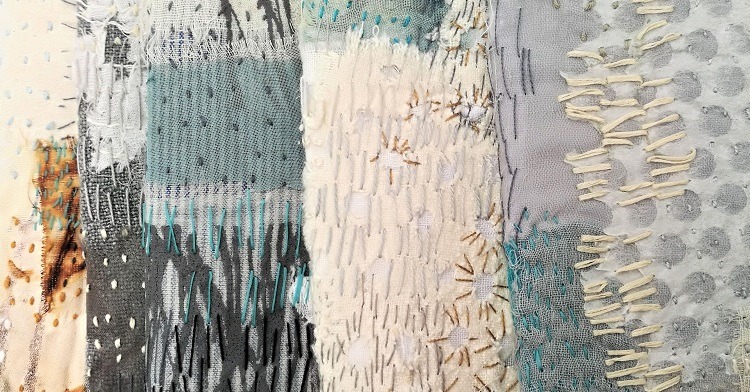
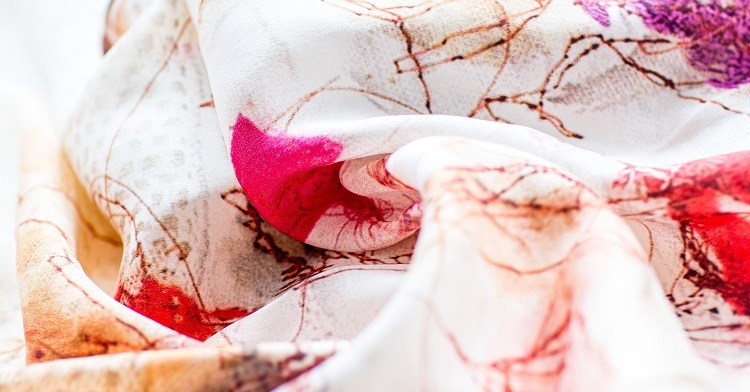
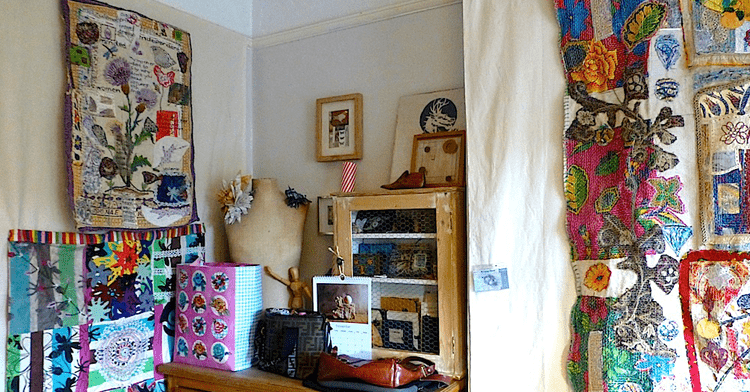
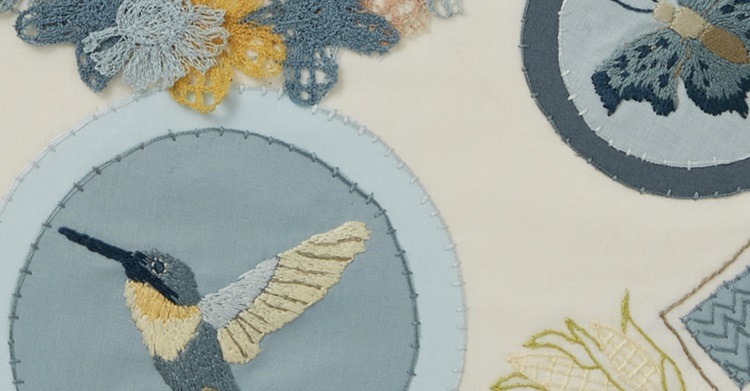
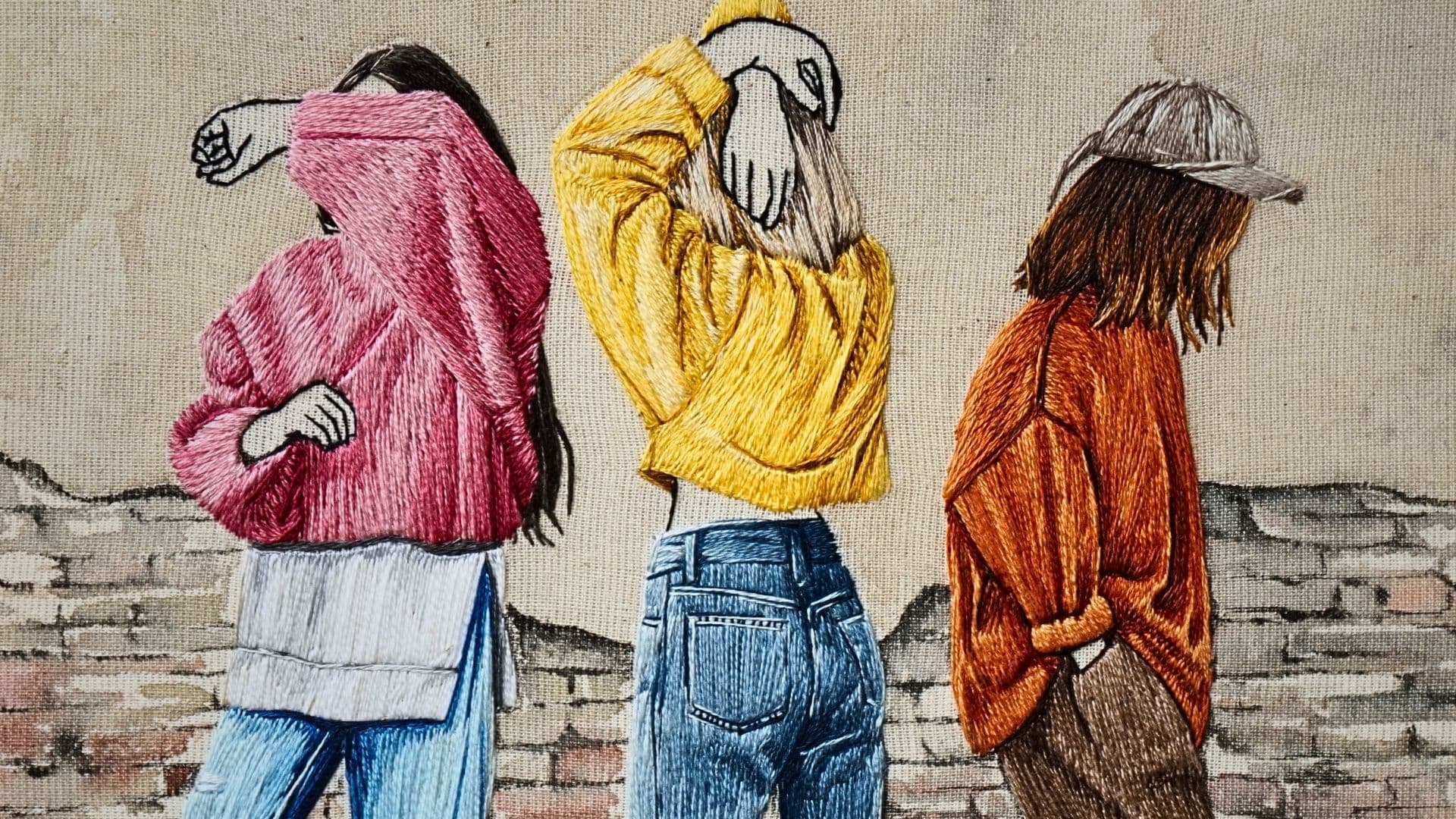
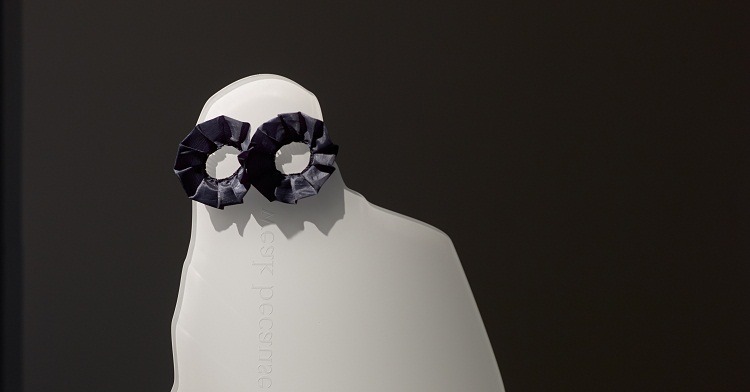
Comments